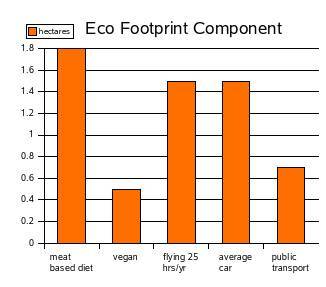According to the UN, the global livestock industry is responsible for more greenhouse-gas emissions than all cars, trains, ships, and planes COMBINED.
More facts and figures…
* More than 50% of U.S. grain and 40% of world grain is fed to animals to produce meat, rather than consumed directly by people. Animals in the United States consume about five times as much grain as is consumed directly by our entire human population.
* Because we need so many crops to feed the billions of animals we consume, we use an enormous amount of land to grow those crops. Approximately one-third of the land area in the United States is devoted to the production of livestock.
* It takes only one-sixth of an acre to supply a vegan with food for one year; it takes three and one-quarter acres to supply a meat eater with food for a year. This means that an acre of land can feed twenty times more vegans than it can meat eaters.
* The need for land to produce grain and forage for animals has resulted in the forest destruction throughout the world; as older pastures are destroyed through overgrazing, new land is cleared to replace them.
* Deforestation to produce more land for crops and grazing results in the release of large amounts of the greenhouse gas, carbon dioxide.
* Almost 90% of the fresh water consumed after withdrawal is for agricultural production, including livestock production. The production of animal protein requires much more water than is required to produce plant protein.
* Animal agriculture results in serious water pollution because animals produce about 1.4 billion tons of waste per year—130 times more than the human population produces. Much of this waste is not recycled but is dumped into our waters, with the result that the nitrogen in the waste reduces the amount of dissolved oxygen in the water and causes levels of ammonia, nitrates, phosphates, and bacteria to increase.
* For example, one hog farm in Utah produces as much waste as does the entire city of Los Angeles.
* The average amount of fossil energy used for animal-protein production is more than eight times the average for grain-protein production.
* Animal agriculture contributes significantly to global warming because cattle, sheep, and goats, in their flatulence and waste, emit 70 to 80 million tons of methane—another greenhouse gas—every year, accounting for as much as 30% of the methane released into the atmosphere.
* Everyday we feed enough grain to American livestock to provide two loaves of bread to every human being on earth.
Sources: World Health Organization; U.S. Department of Agriculture; David Pimentel, “Livestock Production: Energy Inputs and the Environment;” Gary L. Francione, “Introduction to Animal Rights”








